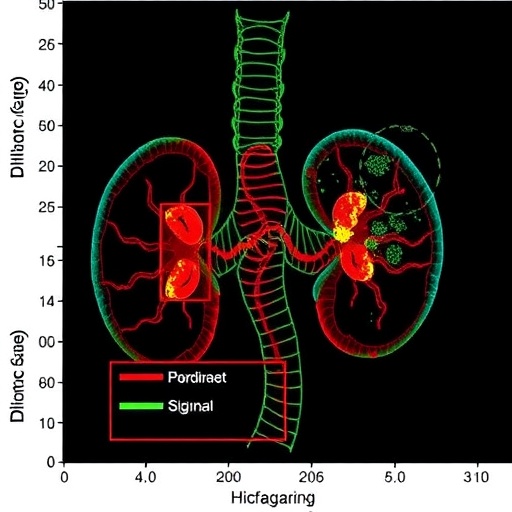In a groundbreaking advancement for nephrology, researchers have uncovered a novel biomarker that could revolutionize the prediction and management of chronic kidney disease (CKD). The international team, led by Baird, Zang, and Connor, has identified low circulating levels of microRNA-190a-5p (miR-190a-5p) as a powerful predictor of CKD progression. This discovery offers a glimmer of hope for millions globally living with this debilitating condition, promising earlier intervention and more personalized treatment strategies.
Chronic kidney disease, characterized by a gradual decline in renal function, often progresses silently until reaching advanced, irreversible stages like end-stage renal disease (ESRD). Current diagnostic tools rely heavily on estimated glomerular filtration rate (eGFR) measurements and proteinuria assessments, which can lag behind actual disease activity. There exists a pressing need for sensitive molecular markers that reflect ongoing pathological changes within kidney tissue before overt clinical symptoms emerge. The study published in Nature Communications brings microRNAs, small non-coding RNA molecules involved in post-transcriptional gene regulation, to the forefront of CKD prognostication.
MicroRNAs have emerged as critical modulators in a wide array of physiological and pathological processes, including inflammation, fibrosis, and cellular apoptosis — all central to CKD pathogenesis. MiR-190a-5p specifically has been implicated in renal cellular homeostasis, but its relevance as a circulating biomarker had not been adequately explored until now. By systematically quantifying serum levels of miR-190a-5p in a large cohort of CKD patients over multiple years, the team connected diminishing miR-190a-5p to accelerated renal function decline.
The methodology underpinning this research exemplifies the next generation of integrated molecular diagnostics. Researchers collected longitudinal blood samples from more than a thousand individuals spanning various CKD stages, alongside comprehensive clinical metadata. Using quantitative polymerase chain reaction (qPCR) techniques optimized for microRNA detection, levels of miR-190a-5p were measured with remarkable precision. Advanced statistical modeling then correlated these molecular readings with eGFR trajectories, adjusting for confounding variables such as age, sex, and comorbidities.
Their analyses revealed that patients exhibiting lower baseline circulating miR-190a-5p had a significantly higher likelihood of rapid CKD progression. This association remained robust even after accounting for traditional risk factors and markers like albuminuria. Intriguingly, the decrement in miR-190a-5p preceded clinical deterioration by an average of 12 to 18 months, highlighting its potential as an early warning sign before irreversible damage accrues. These findings suggest that miR-190a-5p levels could become an essential component of precision nephrology, guiding timely therapeutic interventions.
Mechanistically, the researchers probed how miR-190a-5p contributes to kidney health. In vitro experiments demonstrated that miR-190a-5p suppresses fibrogenic pathways and mitigates inflammatory cascades within renal tubular epithelial cells. The absence or reduction of this microRNA led to unchecked activation of profibrotic genes such as TGF-β1 and connective tissue growth factor (CTGF), key drivers of scarring and fibrosis that culminate in functional loss. This dual role as both a biomarker and modulator of renal pathology underscores its clinical value for diagnosis and potential treatment target.
Despite its promising implications, the study acknowledges limitations warranting further investigation. The sample cohort primarily included individuals of European descent, thus necessitating validation across diverse ethnic backgrounds to ensure universal applicability. Moreover, while observational data establish strong correlation, randomized controlled trials are imperative to confirm that interventions informed by miR-190a-5p surveillance indeed alter clinical outcomes. Future research may also explore how this microRNA interacts with other molecular players in the complex landscape of CKD progression.
Significantly, this discovery aligns with a broader wave of research integrating ‘liquid biopsies’ — minimally invasive blood tests detecting cell-free nucleic acids — into chronic disease management. Such approaches herald a shift from reliance on static imaging and broad biomarkers toward dynamic, molecularly precise monitoring. In the context of CKD, this can translate into stratified patient care, alerting clinicians to impending decline and enabling adjustments in immunosuppressive regimens, blood pressure control, or dialysis timing with unprecedented accuracy.
The translational potential for miR-190a-5p is already compelling pharmaceutical interests as well. Modulating microRNA levels through mimics or inhibitors opens avenues for novel therapeutics aimed at halting or reversing kidney damage. While such RNA-based drugs remain experimental, the identification of miR-190a-5p’s pivotal role lays a foundation for targeted treatment designs. Coupling diagnostic and therapeutic modalities could dramatically improve morbidity and mortality rates associated with CKD.
In parallel, the findings carry profound implications for public health strategies. CKD affects more than 10% of the global population, frequently undiagnosed until advanced stages. Screening programs integrated with miR-190a-5p measurement could enable earlier lifestyle or pharmacologic interventions, reducing the burden on healthcare systems and enhancing patients’ quality of life. Moreover, this microRNA-based biomarker panel could facilitate more efficient clinical trial recruitment by identifying high-risk individuals most likely to benefit from experimental therapies.
The research presented by Baird and colleagues encapsulates a thrilling chapter in personalized medicine, leveraging molecular biology to unravel the complexities of chronic kidney disease. Its elegant combination of clinical data, molecular quantification, and mechanistic exploration exemplifies translational research at its best. As scientists build upon these insights, the future of nephrology appears poised for a paradigm shift toward predictive, preventive, and precise care models.
As it stands, this study not only enriches our understanding of CKD pathophysiology but also showcases the transformative power of microRNAs as biomarkers and therapeutic targets. By integrating cutting-edge molecular diagnostics into nephrology, clinicians may soon move beyond reactive treatment into proactive disease management, dramatically altering CKD’s natural history. The promise of harnessing circulating miR-190a-5p to anticipate and attenuate kidney disease progression marks a beacon of hope for patients worldwide.
In conclusion, the identification of low circulating miR-190a-5p as a predictor of CKD progression emerges as a landmark advance with far-reaching clinical and scientific ramifications. Its potential to serve as an early warning biomarker, a mechanistic contributor to renal fibrosis, and a therapeutic target positions it at the vanguard of nephrological research. As validation studies and clinical applications unfold over the coming years, this discovery heralds a new dawn in the fight against chronic kidney disease, combining molecular insight with tangible patient benefits.
Subject of Research: Chronic kidney disease progression and microRNA biomarkers
Article Title: Low circulating miR-190a-5p predicts progression of chronic kidney disease
Article References:
Baird, D.P., Zang, J., Connor, K.L. et al. Low circulating miR-190a-5p predicts progression of chronic kidney disease. Nat Commun 16, 9154 (2025). https://doi.org/10.1038/s41467-025-64168-6
Image Credits: AI Generated
Tags: chronic kidney disease biomarkersearly intervention in chronic kidney diseaseend-stage renal disease predictorsinflammation and fibrosis in kidney diseasemicroRNA-190a-5p in CKDmolecular markers in kidney diseaseNature Communications study on CKDnephrology advancementspersonalized treatment for CKDpost-transcriptional gene regulation in CKDpredicting CKD progressionrenal function decline





